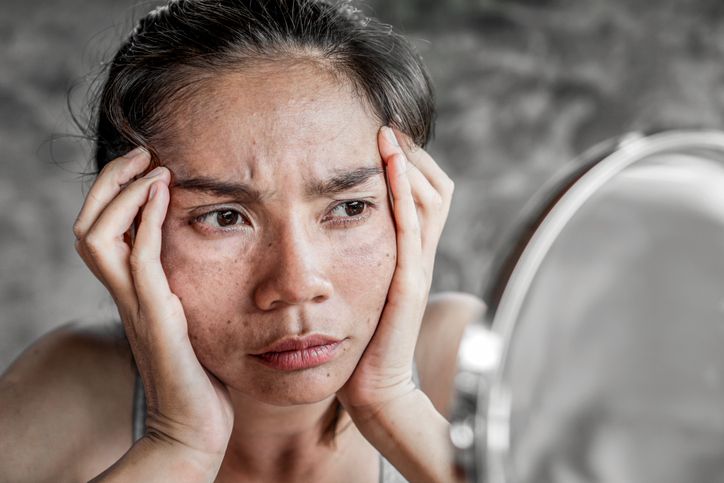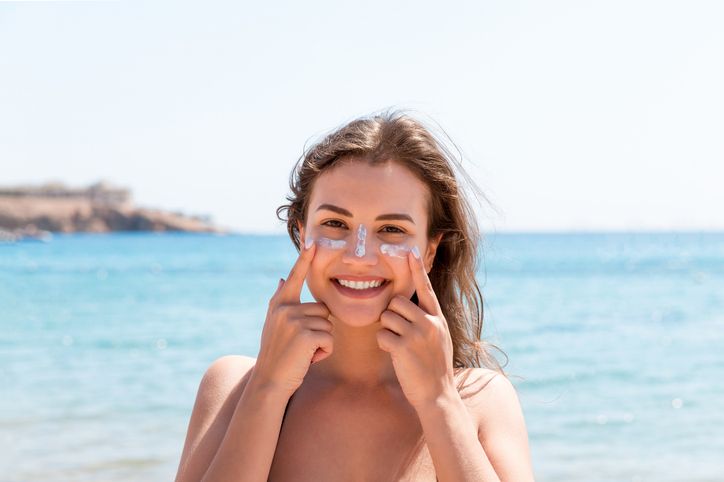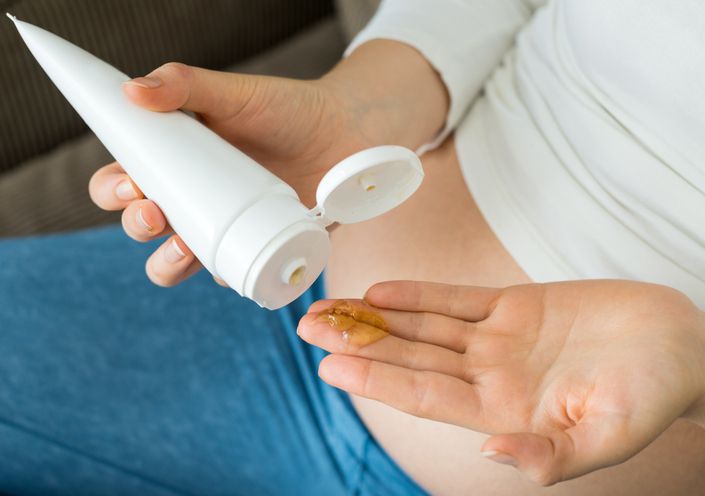- Home
- Trend
- Weight Loss Strategies
- Acne Tips
- Hair Health Information
- Blemish Removal Tips
- Acne Scar Removal Tips
- Muscle Building Techniques
- Intimate Care Tips
- Postpartum Intimate Care
- Eye Bags Wiki
- Tips for Face Slimming
- Secret of Permanent Hair Removal
- Breast Enlargement Tips
- Cure to Snoring
- Marionette Lines
- Skin-Tightening Secrets
Have you ever noticed those pesky dark spots on your face – sometimes called age spots or liver spots – that seem to appear out of nowhere? These are sun spots, and they're a common concern caused by our love affair with the sun. But fear not! This guide will shed light on sun spots, sun damage, and, most importantly, how to achieve a radiant, even skin tone.
Understanding Sun Spots and Sun Damage

Sun spots, also known as solar lentigines, are those flat, dark brown patches that often appear on our faces, hands, arms, and shoulders. These unwelcome visitors are a direct consequence of our skin's reaction to excessive sun exposure.
Imagine melanin as tiny factories within your skin cells that manufacture pigment. When ultraviolet (UV) rays from the sun bombard your skin, these melanin factories go into overdrive. This surge in production aims to create a shield, protecting your deeper skin layers from the sun's harmful rays.
The Downside of Overproduction
Unfortunately, prolonged UV exposure can lead to uneven melanin production. In some areas, melanin production becomes hyperactive, resulting in the formation of darker patches – sun spots. This explains why sun spots are most commonly found in areas regularly exposed to the sun.
While sun spots themselves are generally benign, it's crucial to recognize the broader risks associated with sun damage. Excessive sun exposure is a major risk factor for developing skin cancer, the most serious consequence. It can also accelerate the signs of premature ageing, manifesting as uneven skin tone, wrinkles, and a rough, leathery texture.
How Bad a Sun Exposed Skin Can Be?
Excessive sun or UV exposure can have various visible effects on your skin, indicating the need for protective measures and skincare practices:
1. Sunburn
When your skin absorbs too much UV radiation, it responds with inflammation, leading to sunburn. This condition is characterised by redness, tenderness, and in severe cases, blistering or peeling of the skin. It's a clear sign that your skin has been overexposed and needs immediate care.
2. Uneven Skin Tone
Prolonged exposure to UV rays can disrupt the natural balance of melanin production in your skin, resulting in an uneven skin tone. This may manifest as hyperpigmentation, where dark spots or patches appear, or hypopigmentation, which shows up as lighter areas on the skin. These changes in pigmentation can affect the overall appearance and texture of your skin.
3. Premature Aging Signs
UV radiation is a major contributor to premature ageing of the skin. Over time, excessive sun exposure can lead to the development of wrinkles, fine lines, and sagging skin, particularly noticeable on sun-exposed areas like the face, neck, and hands. These visible signs of ageing can make your skin appear older than it is.
4. Dryness and Dehydration
UV rays can disrupt the skin's natural moisture barrier, leading to dryness, dehydration, and a rough texture. The sun's rays can strip away the skin's natural oils and moisture, leaving it feeling tight, flaky, and lacking in hydration. This dryness can also contribute to a dull complexion.
5. Sunspots
Freckles, age spots, and sunspots are all forms of hyperpigmentation that can develop on areas of the skin exposed to UV radiation without adequate protection. These dark spots are often a result of melanin production triggered by sun exposure and can be challenging to fade without targeted skincare interventions.
6. Increased Sensitivity
Excessive sun exposure can sensitise your skin, making it more prone to irritation, redness, and inflammation. This heightened sensitivity can be uncomfortable and may require gentle skincare products and soothing ingredients to alleviate discomfort.
7. Risk of Skin Cancer
Perhaps the most serious consequence of prolonged sun exposure is the increased risk of developing skin cancer. UV radiation damages the DNA in skin cells, potentially leading to mutations that can result in skin cancer, including melanoma, basal cell carcinoma, and squamous cell carcinoma. Protecting your skin from UV rays is crucial in reducing this risk and maintaining skin health.
免費體驗
PicoCure Pigmentation Removal Treatment
1 Minute Self-Registration
Date should not be before minimal date
When Should I Be Worried About the Appearance of Sunspots?

Sunspots, often harmless on their own, can occasionally signal underlying issues that require medical attention. Here are scenarios where consulting a dermatologist becomes crucial:
Change in Appearance
While sunspots usually maintain a stable appearance, any alterations like changes in size, shape, or colour (such as turning red, blue, or black) should prompt a visit to a dermatologist. These changes could be indicative of more serious conditions like skin cancer, making early detection vital.
Itching or Bleeding
Sunspots typically don't cause discomfort or bleed. If you experience itching or notice any bleeding from a sunspot, it's essential to seek professional evaluation to rule out potential complications.
Rapid Growth
A sunspot that rapidly grows in size is a cause for concern and should be examined promptly by a healthcare professional. Monitoring its growth rate and seeking medical advice can help determine the underlying cause.
Multiple Sunspots
Having numerous sunspots can signify extensive sun damage, potentially elevating the risk of skin cancer. While individual sunspots may be benign, discussing sun protection strategies and conducting a comprehensive skin assessment with a dermatologist is prudent for long-term skin health.
Being proactive about changes in sunspots can aid in early detection and appropriate management of skin conditions, including skin cancer. Regular check-ups with a dermatologist can provide personalised guidance and ensure optimal skin care practices to mitigate risks associated with sun exposure.
Effective Interventions for Sun Spots
Sun damage might seem inevitable, but the truth is, it's largely preventable with a consistent sun protection strategy. Here's your arsenal for shielding your skin and minimising the appearance of existing sunspots:
Sun Protective Clothing
Think of wide-brimmed hats and long-sleeved clothing as your armour against the sun's rays. They provide a physical barrier, especially during peak sun hours (10 am to 4 pm) when UV rays are strongest. Consider lightweight, breathable fabrics for hot weather to ensure comfort and protection go hand-in-hand.
Treat dark spots with technology
In addition to wide-brimmed hats and long-sleeved clothing, consider incorporating advanced pigmentation removal treatments like the Picoway Picosecond Laser Treatment from Perfect Medical into your skincare regimen. This cutting-edge technology targets pigmented lesions, melasma, acne scars, and dull skin, providing rapid and effective pigmentation-lightening results. Pairing sun-smart clothing with innovative treatments ensures both physical protection from UV rays and targeted correction for pigmentation issues, promoting a healthier and more even skin tone.
Sunscreen: Your Daily BFF
Broad-spectrum sunscreen with SPF 30 or higher should be your daily companion, regardless of the weather. Here's why:
• Broad Spectrum Coverage: Sunscreen comes in two types: broad spectrum and UVA/UVB spectrum. Broad spectrum shields your skin from both UVA and UVB rays. UVA rays penetrate deep into the skin, contributing to premature ageing and wrinkles, while UVB rays are responsible for sunburns and increased risk of skin cancer. Opt for broad spectrum for complete protection.
• SPF Explained: Sun Protection Factor (SPF) indicates a sunscreen's effectiveness in blocking UVB rays. SPF 30 blocks about 97% of UVB rays, while SPF 50 blocks 98%. While SPF 50 offers slightly more protection, SPF 30 is sufficient for daily use. For extended outdoor activities or if you have fair skin, SPF 50 might be a better choice.
• Reapplication is Key: Sunscreen's effectiveness diminishes over time due to sweat, swimming, or simply towel drying. To maintain protection, reapply sunscreen every two hours, or more often if you're sweating or swimming.
Seek Shade Whenever Possible
Sometimes, the simplest solution is the best. During peak sun hours, find refuge in the shade of trees, umbrellas, or canopies. This allows you to enjoy the outdoors while minimising sun exposure.
Wear Sunglasses
Don't forget to protect your eyes from harmful UV rays by wearing sunglasses that offer UV protection. Prolonged exposure to UV rays can contribute to eye damage and vision problems. Look for sunglasses that block 100% of UVA and UVB rays for optimal eye protection.
Stay Hydrated
Proper hydration is essential for maintaining healthy skin. Drinking an adequate amount of water helps keep your skin hydrated from within, which can improve its overall appearance and resilience. Dehydrated skin can appear dull and may exacerbate the appearance of sunspots.
Consider Antioxidant Serums
Incorporate antioxidant-rich serums into your skincare routine to combat free radical damage caused by UV exposure. Antioxidants like vitamin C, vitamin E, and green tea extract can help protect your skin from oxidative stress, reduce inflammation, and promote a more even skin tone. Apply antioxidant serums before sunscreen for added protection against environmental aggressors.
Tips on Skin Care Routine to Prevent Excess Pigment
Achieving and maintaining an even skin tone involves adopting daily habits that promote a healthy complexion. Here are some strategies to consider:
1. Consistent Skincare Routine
Establishing a regular skincare routine is essential. Start by cleansing your face gently to remove impurities and excess oil without stripping the skin's natural moisture. Regular exfoliation helps slough off dead skin cells, allowing skincare products to penetrate more effectively. Moisturising with ingredients like hyaluronic acid helps hydrate the skin, keeping it supple and plump.
2. Sun Protection
Consistent sun protection is paramount for maintaining an even skin tone. Use broad-spectrum sunscreen with an SPF of at least 30, even on cloudy days. Reapply sunscreen every two hours, especially if you're outdoors or engaging in water activities. Wearing protective clothing, such as wide-brimmed hats and sunglasses, further shields your skin from harmful UV rays.
3. Topical Treatments and Over-the-Counter Creams
Consider incorporating topical treatments or over-the-counter creams specifically formulated to address sunspots and uneven skin tone. Ingredients like vitamin C, niacinamide, retinoids, and alpha hydroxy acids (AHAs) can help fade dark spots and promote a more uniform complexion. Follow product instructions and be patient, as visible results may take several weeks to months.
4. Natural Remedies
Some natural remedies may complement your skincare routine. Ingredients like aloe vera, green tea extract, licorice extract, and vitamin E possess antioxidant properties that can help protect the skin from environmental damage and promote a radiant complexion. However, it's essential to research and consult with a dermatologist before using natural remedies to ensure they are safe and suitable for your skin type.
免費體驗
PicoCure Pigmentation Removal Treatment
1 Minute Self-Registration
Date should not be before minimal date
Bid Farewell to Skin Pigmentation with the Right Action: PicoWay Picosecond Laser Treatment
While sun protection and skincare routines are crucial for preventing and managing pigmentation, stubborn sun spots on the face and uneven skin tone can sometimes require a more targeted approach. Here's where advanced laser technology like the PicoWay Picosecond Laser Treatment at Perfect Medical comes in.
The PicoWay laser utilises a revolutionary picosecond laser technology. Unlike traditional lasers, it emits ultra-short bursts of energy that shatter pigment particles in the skin. This fragmented melanin is then naturally eliminated by the body, leading to a visible reduction in dark spots, age spots, and uneven pigmentation.
Benefits of Choosing PicoWay Laser Treatment
• Non-invasive and Painless: Experience a comfortable treatment with minimal downtime. Unlike surgery or other invasive procedures, PicoWay offers effective results without compromising comfort.
• Rapid Results, Enhanced Over Time: You'll likely see a noticeable improvement in your skin tone after just one session. As your body removes the shattered pigment particles, the results will continue to improve over time.
• Minimizes the Risk of Rebound: Traditional laser treatments can sometimes trigger post-inflammatory hyperpigmentation (darkening of the treated area). PicoWay's precise technology minimises this risk, leaving you with a more even and radiant complexion.
• Targeted Treatment: The PicoWay laser can precisely target specific pigmented lesions without affecting the surrounding skin. This ensures optimal results with minimal impact on healthy tissue.
Get Rid of Sun Spot On Face In No Time with Our Tips!

Sun spots are a common consequence of sun damage, but with proper sun protection, a dedicated skincare routine and the right treatment, you can achieve an even, healthy skin tone. Remember, sun protection is your best defence. So, embrace the shade, slather on sunscreen, and get ready to reveal your most radiant complexion yet!
免費體驗
PicoCure Pigmentation Removal Treatment
1 Minute Self-Registration
Date should not be before minimal date
FAQ

1. How does UPF clothing contribute to protecting different skin types from intense sun exposure?
UPF clothing provides a physical barrier against harmful UV rays, offering varying levels of protection depending on the fabric and weave. This protection helps prevent severe sunburns and reduces the risk of developing cancerous growths on areas of the body exposed to intense sunlight.
2. Can laser resurfacing treatments effectively fade sunspots and improve skin texture?
Laser resurfacing treatments, such as the Picoway Picosecond Laser Treatment, can effectively target and fade sunspots while also enhancing skin texture. These treatments use advanced technology to break down pigmented lesions, promoting a more even skin tone and reducing the appearance of dark marks caused by intense sun exposure.
3. What are the risks associated with severe sunburns and their potential to lead to cancerous growths on exposed body areas?
Severe sunburns can damage the skin's DNA, increasing the risk of cancerous growths such as melanoma, basal cell carcinoma, and squamous cell carcinoma. Prolonged or intense sun exposure without adequate protection can significantly elevate this risk, emphasising the importance of sun protection measures and early detection of abnormal skin changes.
4. How can lactic acid and apple cider vinegar be used to lighten dark marks and sunspots on the skin?
Lactic acid and apple cider vinegar are natural remedies known for their skin-lightening properties. Lactic acid helps exfoliate the skin, reducing the appearance of dark marks and sunspots over time. Apple cider vinegar, with its acidic properties, can also contribute to fading sunspots and promoting a more even skin tone when used appropriately in skincare routines.
5. What role does sunscreen with a high Ultraviolet Protection Factor (UPF) play in preventing severe sunburns and maintaining even skin texture?
Sunscreen with a high UPF acts as a shield against harmful UV rays, preventing severe sunburns and reducing the risk of developing dark marks and sunspots. Regular use of sunscreen not only protects the skin from immediate sun damage but also helps maintain a smoother and more even skin texture over time.









